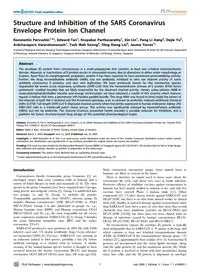
2009 Structure and Inhibition of the SARS Coronavirus Envelope Protein Ion Channel PDF
Preview 2009 Structure and Inhibition of the SARS Coronavirus Envelope Protein Ion Channel
Structure and Inhibition of the SARS Coronavirus Envelope Protein Ion Channel Konstantin Pervushin1,2*, Edward Tan1, Krupakar Parthasarathy1, Xin Lin1, Feng Li Jiang3, Dejie Yu3, Ardcharaporn Vararattanavech1, Tuck Wah Soong3, Ding Xiang Liu4, Jaume Torres1* 1 School of Biological Sciences, Nanyang Technological University, Singapore, 2 Biozentrum of University Basel, Basel, Switzerland, 3 Center for Life Sciences, Department of Physiology, National University of Singapore, Singapore, 4 Institute of Molecular Cell Biology, Proteos, Singapore Abstract The envelope (E) protein from coronaviruses is a small polypeptide that contains at least one a-helical transmembrane domain. Absence, or inactivation, of E protein results in attenuated viruses, due to alterations in either virion morphology or tropism. Apart from its morphogenetic properties, protein E has been reported to have membrane permeabilizing activity. Further, the drug hexamethylene amiloride (HMA), but not amiloride, inhibited in vitro ion channel activity of some synthetic coronavirus E proteins, and also viral replication. We have previously shown for the coronavirus species responsible for severe acute respiratory syndrome (SARS-CoV) that the transmembrane domain of E protein (ETM) forms pentameric a-helical bundles that are likely responsible for the observed channel activity. Herein, using solution NMR in dodecylphosphatidylcholine micelles and energy minimization, we have obtained a model of this channel which features regular a-helices that form a pentameric left-handed parallel bundle. The drug HMA was found to bind inside the lumen of the channel, at both the C-terminal and the N-terminal openings, and, in contrast to amiloride, induced additional chemical shifts in ETM. Full length SARS-CoV E displayed channel activity when transiently expressed in human embryonic kidney 293 (HEK-293) cells in a whole-cell patch clamp set-up. This activity was significantly reduced by hexamethylene amiloride (HMA), but not by amiloride. The channel structure presented herein provides a possible rationale for inhibition, and a platform for future structure-based drug design of this potential pharmacological target. Citation: Pervushin K, Tan E, Parthasarathy K, Lin X, Jiang FL, et al. (2009) Structure and Inhibition of the SARS Coronavirus Envelope Protein Ion Channel. PLoS Pathog 5(7): e1000511. doi:10.1371/journal.ppat.1000511 Editor: Ralph S. Baric, University of North Carolina, United States of America Received March 3, 2009; Accepted June 12, 2009; Published July 10, 2009 Copyright: � 2009 Pervushin et al. This is an open-access article distributed under the terms of the Creative Commons Attribution License, which permits unrestricted use, distribution, and reproduction in any medium, provided the original author and source are credited. Funding: This work has been funded by the Biomedical Research Council (BMRC) of Singapore (grant 04/1/22/19/361). The funders had no role in study design, data collection and analysis, decision to publish, or preparation of the manuscript. Competing Interests: The authors have declared that no competing interests exist. * E-mail:
